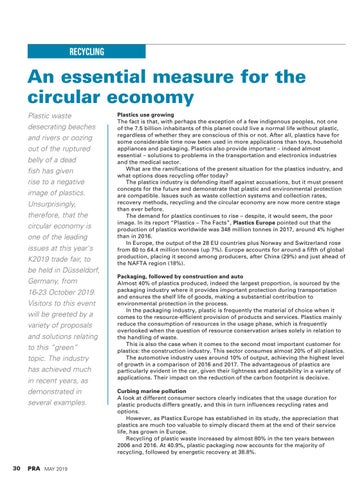Recycling
An essential measure for the circular economy Plastic waste desecrating beaches and rivers or oozing out of the ruptured belly of a dead fish has given rise to a negative image of plastics. Unsurprisingly, therefore, that the circular economy is one of the leading issues at this year's K2019 trade fair, to be held in Düsseldorf, Germany, from 16-23 October 2019. Visitors to this event will be greeted by a variety of proposals and solutions relating to this “green” topic. The industry has achieved much in recent years, as demonstrated in several examples.
30
MAY 2019
Plastics use growing The fact is that, with perhaps the exception of a few indigenous peoples, not one of the 7.5 billion inhabitants of this planet could live a normal life without plastic, regardless of whether they are conscious of this or not. After all, plastics have for some considerable time now been used in more applications than toys, household appliances and packaging. Plastics also provide important – indeed almost essential – solutions to problems in the transportation and electronics industries and the medical sector. What are the ramifications of the present situation for the plastics industry, and what options does recycling offer today? The plastics industry is defending itself against accusations, but it must present concepts for the future and demonstrate that plastic and environmental protection are compatible. Issues such as waste collection systems and collection rates, recovery methods, recycling and the circular economy are now more centre stage than ever before. The demand for plastics continues to rise – despite, it would seem, the poor image. In its report “Plastics – The Facts”, Plastics Europe pointed out that the production of plastics worldwide was 348 million tonnes in 2017, around 4% higher than in 2016. In Europe, the output of the 28 EU countries plus Norway and Switzerland rose from 60 to 64.4 million tonnes (up 7%). Europe accounts for around a fifth of global production, placing it second among producers, after China (29%) and just ahead of the NAFTA region (18%). Packaging, followed by construction and auto Almost 40% of plastics produced, indeed the largest proportion, is sourced by the packaging industry where it provides important protection during transportation and ensures the shelf life of goods, making a substantial contribution to environmental protection in the process. In the packaging industry, plastic is frequently the material of choice when it comes to the resource-efficient provision of products and services. Plastics mainly reduce the consumption of resources in the usage phase, which is frequently overlooked when the question of resource conservation arises solely in relation to the handling of waste. This is also the case when it comes to the second most important customer for plastics: the construction industry. This sector consumes almost 20% of all plastics. The automotive industry uses around 10% of output, achieving the highest level of growth in a comparison of 2016 and 2017. The advantageous of plastics are particularly evident in the car, given their lightness and adaptability in a variety of applications. Their impact on the reduction of the carbon footprint is decisive. Curbing marine pollution A look at different consumer sectors clearly indicates that the usage duration for plastic products differs greatly, and this in turn influences recycling rates and options. However, as Plastics Europe has established in its study, the appreciation that plastics are much too valuable to simply discard them at the end of their service life, has grown in Europe. Recycling of plastic waste increased by almost 80% in the ten years between 2006 and 2016. At 40.9%, plastic packaging now accounts for the majority of recycling, followed by energetic recovery at 38.8%.
